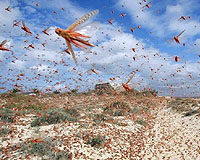 |
Washington DC (SPX) Jun 16, 2009 No human is a clone of their parents but the same cannot be said for other living things. While your DNA is a combination of half your mother and half your father, other species do things differently. The advantage of clonal reproduction is that it produces an individual exactly like an existing one-which would be very useful for farmers who could replicate the best of their animals or crops without the lottery of sexual reproduction. Clonal reproduction of crop species took a step closer to being realised with new research published in PLoS Biology this week. The type of cell division that creates eggs and sperm is called meiosis, and it differs from 'normal' cell division (mitosis) because instead of producing two genetically identical daughter cells, it produces four cells each containing only half of the parental amount of DNA. Meiosis occurs in all species that reproduce sexually, from microorganisms such as yeast to plants, animals and human beings. This new paper blurs the line between the two different types of cell division by showing a plant where three specific mutations are experimentally combined. These divisions are normally meiotic - which make pollen and egg cells - and are replaced by mitotic divisions. The work, by a team of researchers in France and Austria, is potentially very important commercially, because it makes the creation of stable new mutant crops-such as plants of a different colour, or with a different yield, etc.-much simpler. It is now much closer to being po ssible to reproduce a plant that produces perfect potatoes, maize or rice, without the lottery of reassortment that each meiotic division and ensuing fertilization introduces. The first steps of both meiosis and mitosis are the replication of the dividing cell's DNA. Once replication has occurred, the chromosomes condense into tightly bound structures, and in mitosis these form an X shape in which each half of the X is a chromatid, comprising one complete copy of the chromosome. The double-chromatid chromosomes line up along the centre of the cell. In mitosis, the two chromatids are pulled apart-the X is divided along one axis of symmetry-and these then pass into two genetically identical daughter cells. In meiosis, there are two lining up and dividing phases. The first lining up is of homologous chromosomes-all chromosomes in an adult cell have a partner, members of the partnership coming from the mother and father of the cell-and these homologous chromosomes are each made up of two chromatids. The first division divides homologous pairs of chromosomes while the second meiotic division is just like the mitotic di vision: the chromosomes line up at the middle of the new cell and the chromatids divide at the centre of the X. Thus the differences between mitosis and meiosis are that meiosis has two rounds of division; co-segregation of sister chromatids at the first division; and recombination that occurs during the first division-a swapping over process that adds more genetic diversity to offspring. The new work, led by Raphael Mercier, identifies a gene that controls one of these three features-entry into the second meiotic division-in the sexual plant Arabidopsis thaliana. By combining a mutation in this gene with two other previously described mutations-one that eliminates recombination and another that modifies chromosome segregation-the authors have created a strain of plant (called MiMe for 'mitosis instead of meiosis') in which meiosis is totally replaced by mitosis. MiMe plants produce pollen and eggs that are genetically identical to their parent. If MiMe eggs are self-fertilized by MiMe sperm, the offspring plant has twice as much DNA as the parent generation, and has all the genes from this single parent. Thus the authors have made a form of asexual reproduction possible in a normally sexual species. Turning meiosis into mitosis is not enough to reach clonal reproduction, but it's a giant leap towards it. This has potential revolutionary applications in crop improvement and propagation. Share This Article With Planet Earth
Related Links Public Library of Science "Plants producing 2N gametes or apomeiotic gametes" Farming Today - Suppliers and Technology
 Local fare gets top billing in 'locavore' food trend
Local fare gets top billing in 'locavore' food trendVancouver, Canada (AFP) June 15, 2009 The succulent braised rabbit served up at Raincity Grill comes garnished with a mound of curled wild lettuce, harvested from the mountains surrounding Vancouver. In fact, the rabbit itself -- and nearly every other menu item at this trendy beachside restaurant -- is from a nearby farm or producers' market. This west coast Canadian city is a mecca for so-called "locavores" who eat ... read more |
|
| The content herein, unless otherwise known to be public domain, are Copyright 1995-2009 - SpaceDaily. AFP and UPI Wire Stories are copyright Agence France-Presse and United Press International. ESA Portal Reports are copyright European Space Agency. All NASA sourced material is public domain. Additional copyrights may apply in whole or part to other bona fide parties. Advertising does not imply endorsement,agreement or approval of any opinions, statements or information provided by SpaceDaily on any Web page published or hosted by SpaceDaily. Privacy Statement |